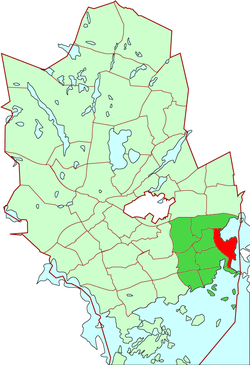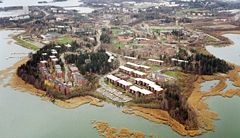- Otaniemi
-
Otaniemi
Otnäs— District of Espoo — Location of Otaniemi within Espoo Country Finland Municipality Espoo Region Uusimaa Sub-region Greater Helsinki Main District Suur-Tapiola Inner District(s) Otaniemi, Keilaniemi Population (2006) - Total 3,496 Languages - Finnish 82.6 % - Swedish 4.3 % - Other 13.2 % Jobs 12,826 Otaniemi (Finnish), or Otnäs (Swedish), is a district of Espoo, Finland. It is located near the border of Helsinki, the capital of Finland.
Otaniemi is the home of the Helsinki University of Technology (TKK) campus; "Otaniemi" is often used as a synonym for TKK. However, several research and business facilities are also located in Otaniemi. The most prominent institutions for science and engineering in Otaniemi are the Finnish Innovation Center, VTT Technical Research Centre of Finland, the Micronova Center of Micro and Nanotechnology, the KCL pulp and paper research center, the CSC IT Center for Scientific Computing, the Geological Survey of Finland (GTK), and the National Bureau of Measures (MIKES). Business is represented in the area by the business incubator Technopolis. On 1 January 2010, Otaniemi became home to Aalto University, formed from the merger of the Helsinki University of Technology, the University of Art and Design Helsinki, and the Helsinki School of Economics.
Otaniemi hosts a vibrant—and at times rowdy—student community especially concentrated in the several blocks of student housing called Teekkarikylä (Swedish: Teknologbyn, literally technology students' village). Some buildings of Teekkarikylä are owned by the student association of TKK; others are owned by HOAS.
Many buildings located in the Otaniemi campus area, including the main building of TKK, were designed by the world-renowned Finnish architect Alvar Aalto. For this reason, the area is protected as a national scenic area, representing the modernist and functionalist architecture for which Finland is internationally famous.
Contents
History
As late as the 1940s, Otaniemi was farmland. In 1949, the Government of Finland purchased the lands of Otaniemi Manor for use as the campus of the Helsinki University of Technology and the VTT Technical Research Centre of Finland. First to be built was the student campus of the Helsinki University of Technology, which also served as one of the Olympic Villages in the 1952 Summer Olympics. Several thousand students currently live in Otaniemi. The region has since been built up around TKK and VTT, and is at the core of Finnish scientific and technological activities. The area is architecturally unique, boasting buildings designed by leading Finnish architects including Alvar Aalto, Heikki and Kaija Sirén, and Reima and Raili Pietilä. Aalto is an alumnus of TKK, and the designer of both the city plan for the Otaniemi area and the main building of TKK.
Education
On 1 January 2010, Otaniemi became home to Aalto University, formed from the merger of the Helsinki University of Technology, the University of Art and Design Helsinki, and the Helsinki School of Economics. The name of the university symbolizes change, and is a tribute to Alvar Aalto, a prominent architect known for his achievements in technology, economics, and art.
Aalto University creates a new science and arts community by bringing together three existing universities of technology, economics and art. The combination of three universities opens up new possibilities for strong multi-disciplinary education and research.
Research and development
Otaniemi is home to many of Finland's research and development organizations: The most prominent institutions for science and engineering in Otaniemi are the Finnish Innovation Center, VTT Technical Research Centre of Finland, the Micronova Center of Micro and Nanotechnology, the KCL pulp and paper research center, the CSC IT Center for Scientific Computing, the Geological Survey of Finland (GTK), and the National Bureau of Measures (MIKES). Helsinki University of Technology's 10 national centers of excellence create most of Finland's hi-tech patents within this small area.
Social roots of information technology in Otaniemi
Otaniemi has gained international recognition in information and communication technologies thanks largely to Nokia, but it also contains a host of other cutting-edge technology clusters, including mobility-based software and web-ware, as well as nanotechnology and microelectronics.
See also
External links
Maps
Pohjois-Espoo (Norra Esbo) Bodom | Kalajärvi | Lahnus | Lakisto | Luukki (Luk) | Niipperi (Nipert) | Perusmäki (Grundbacka) | Röylä (Rödskog) | Vanhakartano (Gammelgård) | Velskola (Vällskog)
Suur-Espoonlahti (Stor-Esboviken) Espoonlahti (Esboviken) | Kaitaa (Kaitans) | Latokaski (Ladusved) | Nöykkiö (Nöykis) | Saunalahti (Bastvik) | Soukka (Sökö) | Suvisaaristo (Sommaröarna)Suur-Kauklahti (Stor-Köklax) Suur-Leppävaara (Stor-Alberga) Suur-Matinkylä (Stor-Mattby) Suur-Tapiola (Stor-Hagalund) Haukilahti (Gäddvik) | Laajalahti (Bredvik) | Mankkaa (Mankans) | Niittykumpu (Ängskulla) | Otaniemi (Otnäs) | Pohjois-Tapiola (Norra Hagalund) | Tapiola (Hagalund) | WestendVanha-Espoo (Gamla Esbo) Espoon keskus (Esbo centrum) | Gumböle | Högnäs | Järvenperä (Träskända) | Karhusuo (Björnkärr) | Karvasmäki (Karvasbacka) | Kaupunginkallio (Stadsberget) | Kolmperä (Kolmpers) | Kunnarla (Gunnars) | Kuurinniitty (Kurängen) | Muurala (Morby) | Nupuri (Nupurböle) | Nuuksio (Noux) | Siikajärvi | Vanha-Nuuksio (Gamla Noux)Categories:
Wikimedia Foundation. 2010.


